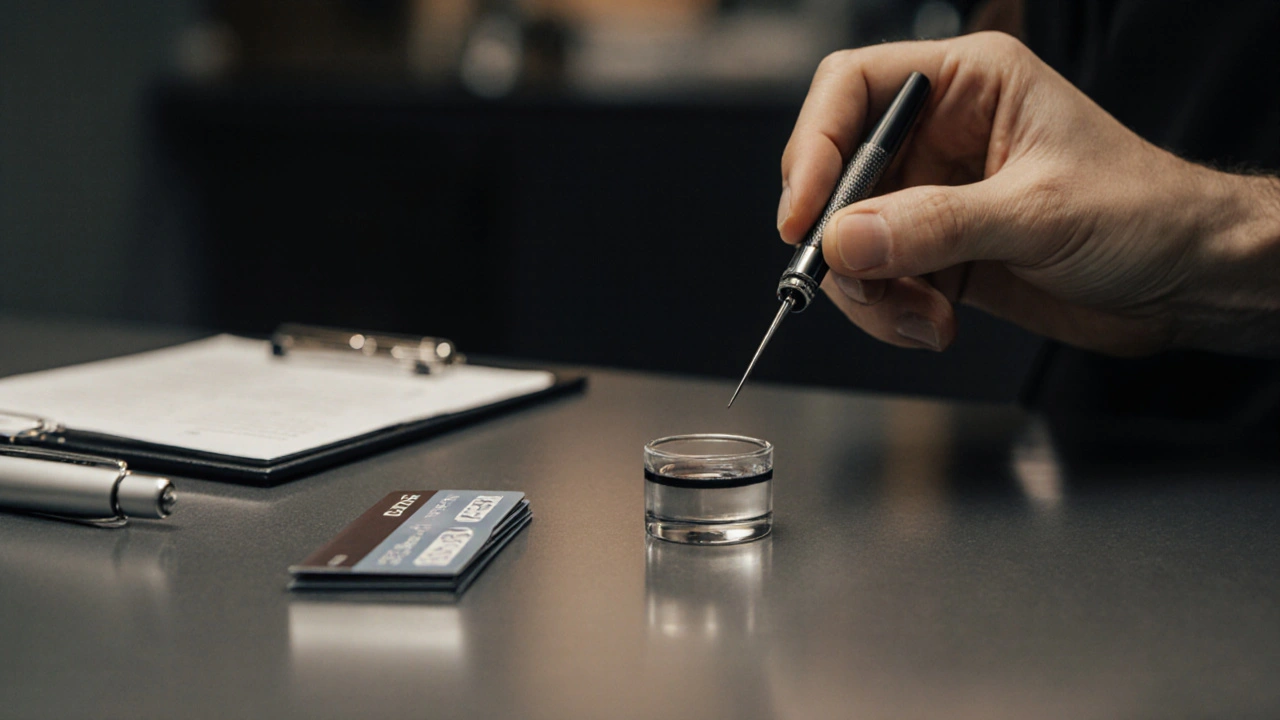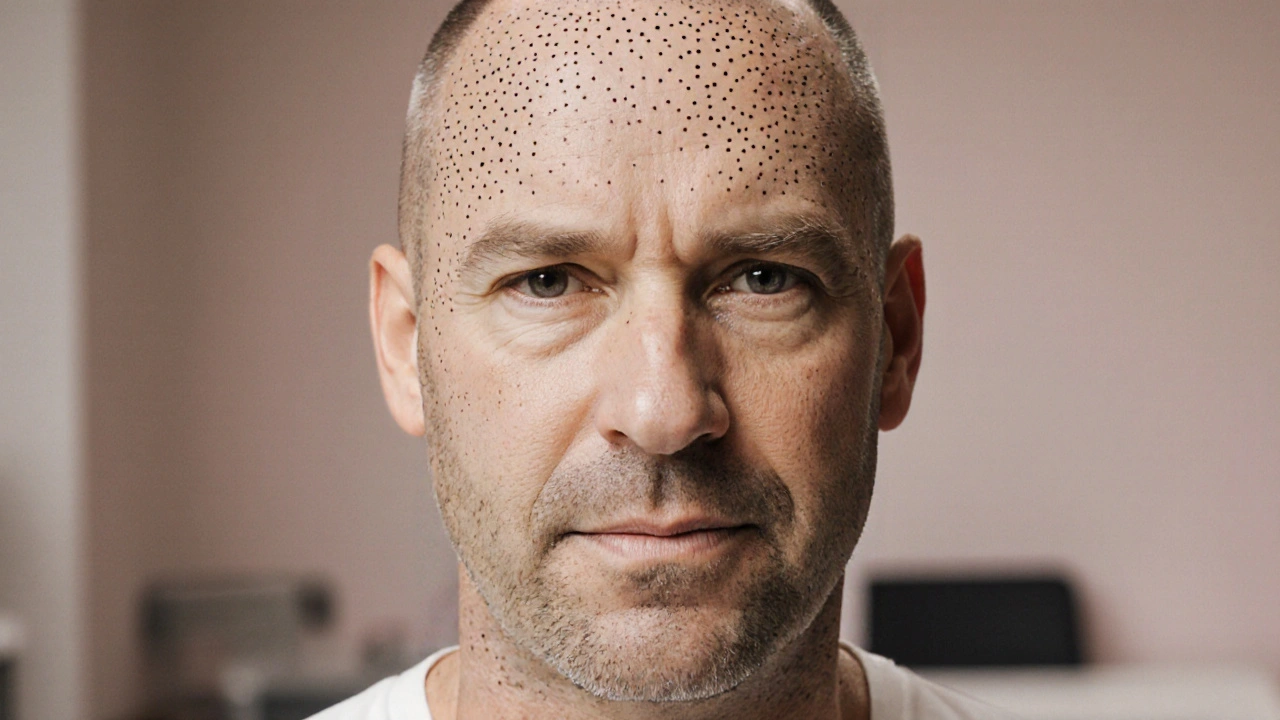Quick Summary
- Androgenic alopecia is a genetic pattern‑hair loss affecting millions worldwide.
- Scalp micropigmentation (SMP) is a non‑surgical pigment‑tattoo that mimics the look of real hair follicles.
- The SMP process takes 2‑4 sessions, costs between AU$2,500‑AU$5,500, and lasts 8‑10 years with proper care.
- SMP complements or replaces other options such as hair transplants, minoxidil, and finasteride.
- Choosing a qualified artist, checking before‑and‑after photos, and following after‑care guidelines are key to lasting results.
Androgenic Alopecia is a hereditary form of hair loss that follows a predictable pattern in men and women. It usually starts with a receding hairline or thinning crown in men, while women commonly notice diffuse thinning over the top of the scalp. The condition is driven by the hormone dihydrotestosterone (DHT) acting on genetically‑sensitive hair follicles, shortening the growth phase and eventually shutting the follicles down.
For many, the sight of receding hair or a widening part triggers a search for a quick fix. Over‑the‑counter products, prescription drugs, and surgical transplants dominate the market, but each comes with trade‑offs-whether it’s the need for daily application, costly procedures, or a long recovery period.
Scalp Micropigmentation (commonly abbreviated as SMP) is a cosmetic tattoo technique that deposits tiny pigment dots into the upper dermis, replicating the visual density of hair follicles. When done correctly, SMP creates the illusion of a shaved‑head look or fills in areas of thinning hair, giving the wearer a fuller, more natural appearance.
How Scalp Micropigmentation Works
The SMP artist first assesses the client’s hair loss pattern, skin tone, and desired density. Using a medical‑grade, hypoallergenic pigment, the artist then applies the dots with a single‑needle or multi‑needle device. Each dot measures about 0.2‑0.3mm-roughly the size of a real follicle-so the result blends seamlessly with existing hair.
Because SMP targets the epidermis rather than the deeper dermis, the pigment stays stable for years but eventually fades as the skin naturally renews. Touch‑up sessions can refresh the colour and keep the look crisp.
Typical SMP Procedure Timeline
- Consultation (30‑45min): Discuss hair loss stage, colour matching, and design layout.
- Patch Test (15min): Apply a small amount of pigment to ensure no allergic reaction.
- First Session (2‑3hrs): Cover the front hairline and crown, usually 40‑60% of the total area.
- Second Session (2‑3hrs, 1‑2weeks later): Finish the remaining sections and add shading for depth.
- Optional Third Session (optional, 2‑4weeks after Session2): Refine details or increase density if needed.
Most clients see a dramatic improvement after the second session because the pigment settles and the scalp’s natural colour blends with the dots.
Benefits Compared to Traditional Hair‑Loss Solutions
| Solution | How it Works | Typical Cost (AU$) | Maintenance | Results Longevity |
|---|---|---|---|---|
| Scalp Micropigmentation | Pigment dots mimic follicle shadows | 2,500-5,500 | Touch‑ups every 5‑8years | 8‑10years (with upkeep) |
| Hair Transplant (FUE) | Autologous grafts surgically placed | 7,000-15,000 | Post‑op care, possible meds | Permanent (if grafts survive) |
| Medication (Minoxidil / Finasteride) | Stimulates follicle growth / blocks DHT | 200-500 per year | Daily application or prescription | Only while using; hair loss resumes if stopped |
Unlike Hair Transplant, SMP requires no incisions, no anesthesia, and virtually zero downtime. It also avoids the side‑effects of Minoxidil (scalp irritation) and Finasteride (sexual dysfunction concerns). For men who want a shaved‑head look or women who dislike the idea of a surgical scar, SMP offers a discreet, cost‑effective alternative.
Who Benefits Most from SMP?
- Early‑stage androgenic alopecia: Fills in thinning patches before they become large bald spots. \n
- Post‑hair‑transplant or post‑balding: Camouflages any remaining gaps or scar tissue.
- Patients with medical hair loss (e.g., alopecia areata): Provides a temporary aesthetic solution while the underlying condition is treated.
- Anyone seeking a low‑maintenance look: Once healed, the scalp looks full without daily products.

Potential Drawbacks and How to Mitigate Them
While SMP is safe, there are a few caveats. Over‑pigmentation can give a ‘muddy’ appearance, especially on darker skin tones. Choosing an artist who tailors pigment shade to your natural hair colour and skin undertone reduces this risk. Additionally, excessive sun exposure can accelerate fading; using a broad‑spectrum SPF 30+ sunscreen helps preserve the pigment.
Clients should also be realistic: SMP does not grow hair; it creates the illusion of density. Those wanting actual follicular regrowth will still need to consider medication or transplant options.
Choosing the Right SMP Provider
- Verify credentials: Look for certifications from reputable bodies such as the International Society of Micropigmentation or equivalent Australian training programs.
- Review portfolio: Check before‑and‑after photos of clients with a similar hair‑loss pattern and skin tone.
- Ask about pigments: High‑quality, FDA‑approved pigments reduce allergic reactions and ensure colour stability.
- Discuss after‑care: A clear post‑procedure plan (cleaning, sunscreen, touch‑up schedule) signals professionalism.
- Read reviews: Look for feedback on punctuality, hygiene, and long‑term satisfaction.
After‑Care Checklist
- Keep the scalp clean for the first 48hours; use a gentle, fragrance‑free cleanser.
- Avoid sweating, saunas, and direct sunlight for at least one week.
- Apply a thin layer of fragrance‑free moisturizer to soothe any redness.
- Use SPF 30+ sunscreen daily after the first week.
- Schedule the first touch‑up 4‑6months after the final session.
Cost Considerations and Financing Options
In Australia, the price range reflects the artist’s experience, clinic location, and the size of the area treated. Many reputable studios offer payment plans spread over 3‑6months, making the upfront cost more manageable. Some clinics also bundle the initial three‑session package with a free touch‑up within the first year.
When budgeting, factor in the long‑term expenses: occasional touch‑ups, sunscreen, and any complementary therapies (e.g., low‑level laser therapy for scalp health).
Bottom Line: Is SMP the Right Choice?
If you’ve tried minoxidil, finasteride, or even a transplant and still feel uneasy about the look of thinning hair, SMP can give you a confident, low‑maintenance appearance within weeks. It works best when paired with a realistic expectation-SMP masks the problem rather than cures it. By selecting a certified artist, following the after‑care routine, and budgeting for periodic refreshes, you can enjoy a lasting, natural‑looking solution to androgenic alopecia.

Frequently Asked Questions
Can SMP be combined with a hair transplant?
Yes. Many patients use SMP to camouflage scar tissue or fill in thin spots left after a transplant. The combined approach often yields a denser, more uniform appearance.
How long does the SMP procedure take?
A full scalp treatment typically requires two to three sessions, each lasting 2‑4hours. Sessions are spaced 1‑2weeks apart to allow the skin to settle.
Is SMP painful?
Most clients describe the sensation as a mild tingling, similar to a light tattoo. Numbing creams are optional but rarely needed.
Will the pigment fade over time?
Yes, gradual fading is normal as skin cells renew. Proper after‑care and a touch‑up every 5‑8years keep the colour vivid.
Can I get SMP if I have a dark skin tone?
Absolutely. Skilled artists blend pigments to match undertones, ensuring the dots appear natural without a harsh contrast.


SMP looks cheap but works fast.